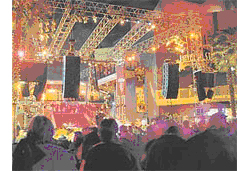At last count… well, I stopped counting. Suffice to say that dozens of companies now offer line array loudspeaker systems that are more than simple column designs.
Rather than discussing dozens of different product types, I thought we might approach the subject by defining the technological terms of line arrays. This way, we get a better grasp of the issues involved with line array systems and will be able to discern both the similarities of – and unique differences between – these now ubiquitous products.
A Little History
Line arrays have been around for over a half of a century as column loudspeakers, and other than those made by Rudy Bozak in the U.S., most were voice-range only.
Their application was generally for highly reverberant spaces, where a narrow vertical dispersion avoided exciting the reverberant field, provided a higher Q (narrower dispersion pattern) and, as a result, improved intelligibility of the spoken word.
Never losing popularity in Europe as they did in America, it’s no wonder that L-Acoustics V-DOSC line array loudspeakers from France were the first (in the mid-1990s) to show the concert sound world that more level and smoother frequency response can come from fewer drivers in a line array.
After everyone realized that for a given listening area, the drivers have no destructive interference in the horizontal plane and combine mostly inphase in the vertical plane, the race was on.
Cylindrical Waveform
Basically, a line of sources will create a wavefront of sound pressure that is loosely cylindrical in nature at a particular range of wavelengths (frequencies).
Its idealized shape is actually more like a section of a cake, and the wavefront surface area, as it expands only in the horizontal plane, doubles in area for every doubling of distance. This equates to a 3 dB SPL loss of level for every doubling of distance.
Spherical Waveform
An idealized point source, imperfectly represented by a loudspeaker or nonlinear cluster of loudspeakers, radiates in a spherical waveform rather than cylindrical. The wavefront expands to four times the area with each doubling of distance, which equates to a 6 dB SPL loss for every doubling of distance.
This is commonly known as the inverse-square law, and it applies to all point-source radiant energy.
Hence the big advantage for a line array is that for a given number of transducers, the resulting long throw level can be much greater than for a non-line array, or point-source, loudspeaker system.
Interference Pattern
This is the term applied to the dispersion pattern, or response balloon of a line array. It simply means that when you stack a bunch of loudspeakers, the vertical dispersion angle decreases because the arrivals from individual drivers are out of phase with each other at positions off-axis in the vertical plane.
The taller the stack is, the narrower the vertical dispersion will be and the higher the sensitivity will be on-axis. In the horizontal plane, an array of like drivers will have the same polar pattern as a single driver.
Some believe that the horizontal pattern is wider than for a single driver, but they are mistaken, likely fooled by the fact that the level is louder off to the side due to the higher sensitivity of multiple drivers. However, the actual polar pattern remains the same as for a single driver.
Array Length
In addition to the narrowing vertical coverage angles, the array length also determines what wavelengths will be affected by this narrowing of dispersion. The longer the array, the lower in frequency (longer in wavelength) the pattern control will occur.
Critical Distance
There is a limit to the 3 dB per doubling loss, and it’s at this point where the array is far enough away to appear to be more of a point source and its level begins to attenuate according to the inverse-square law at 6 dB per doubling of distance. The transition between these two regions is known as the critical distance for the line array.
The region closer than critical distance, and the region beyond it, are termed as the Fresnel and Fraunhofer regions, respectively, so named by Christian Heil of L-Acoustics. Unless you’re a true math dweeb, near-field region and far-field region roll off the tongue a bit easier.















